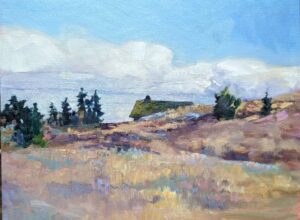
Near the wonderful, loose Andrew Wyeth watercolors at the Farnsworth Art Museum is a small room dedicated to his painting practice. You are surrounded by his careful investigation of details, compositional sketches, and studies. “When I was painting Christina’s World I would sit there by the hours working on the grass, and I began to feel I was really out in the field. I got lost in the texture of the thing. I remember going down into the field and grabbing up a section of earth and setting it on the base of my easel. It wasn’t a painting I was working on. I was actually working on the ground itself,” he said.
Edward Hopper, who mined similar veins of alienation as Wyeth, was known for meticulously storyboarding his major paintings. He drew thousands of preparatory sketches. A comparison of one of his final sketches for Nighthawks with the final painting shows just how important his drawings were in cutting things down to the bone. He used drawing to shake off the burden of representational reality.
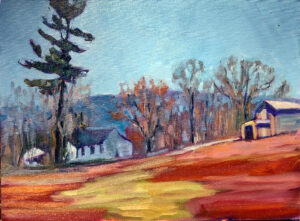
Modern plein air painting
On the flip side, there’s contemporary plein air painting, dashed off in alla prima technique in a matter of a few hours. I love plein air painting myself, but a recent conversation with a student had me wondering about its lasting value. She is frustrated with her local painting group, which never works more than two or three hours. “What’s the point of rushing like that?” she asked me.
There are hundreds of plein air events in the United States every year, each of which has around thirty juried artists, each of whom in turn produces 5-10 works per event. That means the art market is flooded with tens of thousands of paintings from these events alone. Not all of them are good. I’ve produced more than my share of duds.
These events create a commodity that’s affordable to a middle-class audience. There’s nothing inherently wrong with that; it’s what drove the Dutch Golden Age of Painting, which gave us Vermeer, Frans Hals and Rembrandt.
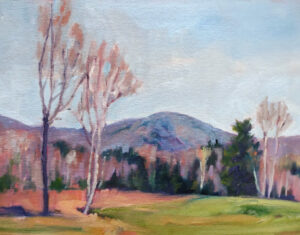
But it’s equally true that mass movements give us our share of dreck. The paintings done at plein air events are often safe (read ‘boring’) and dashed off without a lot of thought. That’s because plein air events are a production grind.
Loose brushwork has become the norm of plein air painting. But there’s no law that says that plein air must be quick, or that loose brushwork is the apotheosis of outdoor painting. These are just tropes of our times. Leaning into them too heavily just makes you a copier of other people’s ideas.
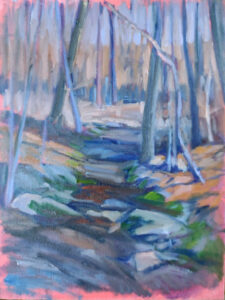
Go outside and take your time
This spring in the northeast is miserably cold and wet. I’ve painted outdoors just twice. Out of the three things I did, the one I like is the least-finished (above). In the other two, I was tinkering, trying to feather trees like Chauncey Ryder. Everything else in my paintings suffered. I don’t care; I’ll wipe out the boards and try again.
I have my eye on another stand of trees, small spruces. I want to see if I can mimic the soft brushwork of Anders Zorn in them, since to me he’s the only person who ever painted baby evergreens convincingly.
“You’re going to confuse yourself with all this mimicry!” Eric Jacobsen chided me. Well, no, because I don’t really want to paint like Ryder or Zorn. I want to figure out how they did this specific soft-focus thing on trees. I could never do this if I was still rushing around churning out three-hour paintings at events. The cost of failure is too great.
My 2024 workshops:
- Sea & Sky at Schoodic, August 4-9, 2024.
- Find your authentic voice in plein air: Berkshires, August 12-16, 2024.
- Art and Adventure at Sea: Paint Aboard Schooner American Eagle, September 15-19, 2024.
- Immersive In-Person Workshop: Rockport, ME, October 7-11, 2024.

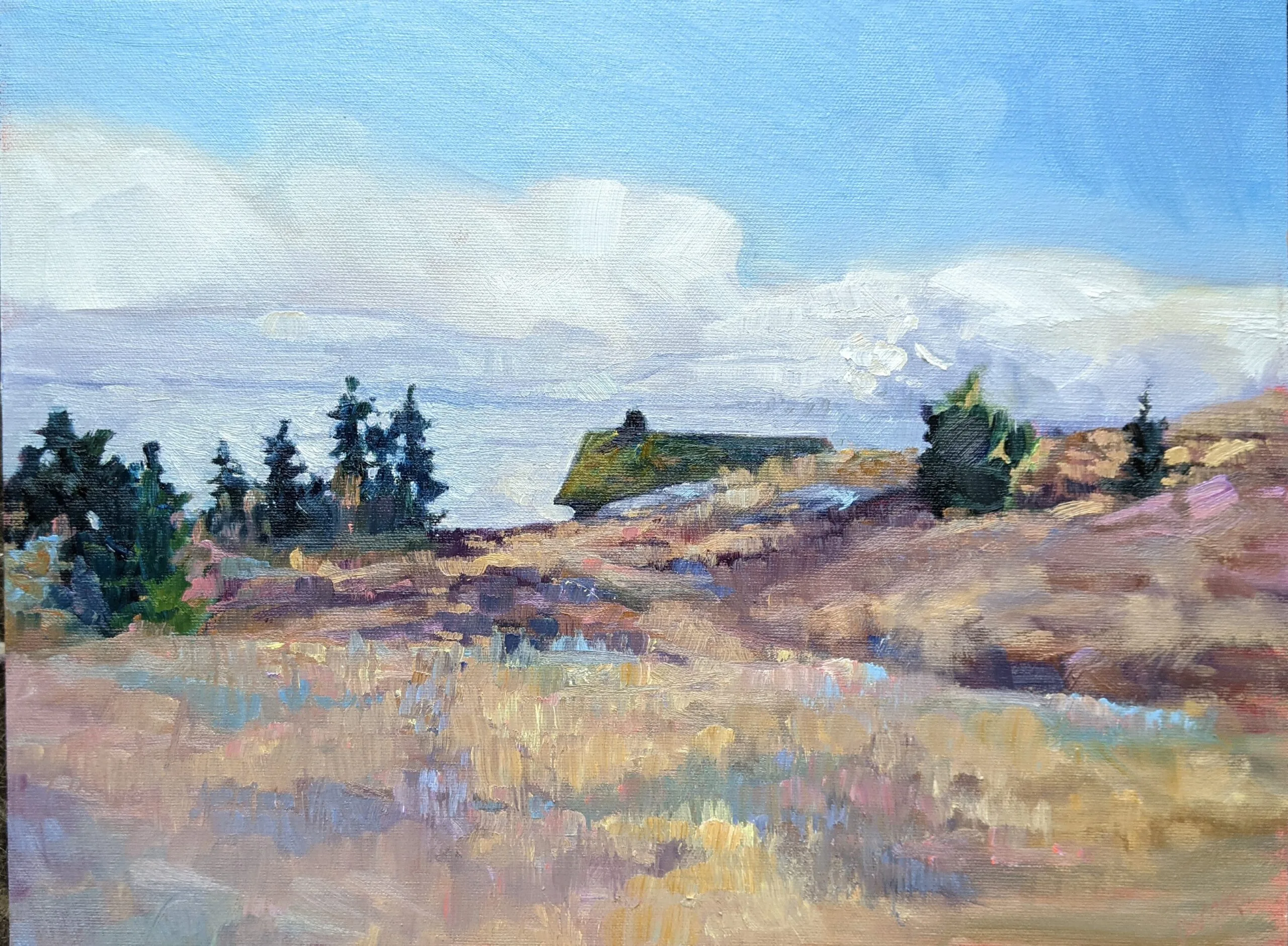
I just finished a plein air event… I am still recovering. The only painting I sold was one I brought with me that I worked on for days, using a plein air study. I might be better off entering traditional gallery shows. IDK.
That’s very disappointing, Judi. There’s no “one size fits all” answer to selling, and in my experience, it doesn’t work the same way over time, either.
I saw your work from Marble Falls and it was lovely. Thanks for that.
Thanks for this Carol.
It wasn’t until I started spending multiple sessions out painting Plein air that I started to truly enjoy it. I understand how the urgency of trying to capture a certain light or moment can be beneficial to one’s process -get you out of your head. But I find multiple visits with the same canvas allows me to become so much more intimate with my surroundings. I’m more relaxed and I think it shows in the work.
I so appreciate this, being a very slow starter myself. Some of my best work has had its beginnings in plein air studies and its refining in the studio. I love painting outdoors but all my knowledge flees as I fall under a spell. Thanks for your wonderful blog!❤️
Thank you, Carol, I needed to read this.
Enjoyed your perspective in this article. I’m not a very patient painter. I also tend to paint too tightly. Plein air almost requires me to be loose and more impressionistic. I last about an hour; by then my back needs a break and my painting is covered with oil paint. Forces me to stop before the “mud” stage and I lose all the “freshness”. Interestingly, when I look at it after a few days, it is often nearly finished! Again, I’m careful not to mess up the freshness! Took me a long time to learn that! Really enjoy your blog! Thanks for sharing!
At Planet Fitness they have a sign that says ” Judgement Free Zone.” As you work on your body, you can thank yourself for just showing up and getting to work FOR YOURSELF. My attitude about plein air painting is also ” for yourself” first. In a plein air event, the parameters are preset, by someone else. So there seems to be an unspoken expectation that works that sell are framed a certain way, painted a certain way, painted in large part, in oils. Where is their room for…..discovery? Too many artists paint the same damn thing over and over but where is the growth.? The joys of painting outdoors are numerous and there should be some room for uncovering something novel that will compel a viewer to want to have it in their collection. I used to get a magazine that specialized in plein air work, and then presented in ads a select group of painters as “superstars” who would be demonstrating at plein air conventions. No more. My studio is filled with work done outside and inside, from life and photo reference I take. From finished to partially finished, from false starts and work that has traction, from what nature has presented to me and from what I conceptualized from seed ideas. In total, it adds up to how I go about what is important, how I go about doing what I do. Maybe no one elses cup of tea, but it is mine. I, like Planet Fitness, work in a judgement free zone.
And you are, as a result of your attitude, one of the most accomplished plein air painters I know. I have your work hanging in my dining room. That’s a very select and small cohort, and there’s a reason you’re in it.